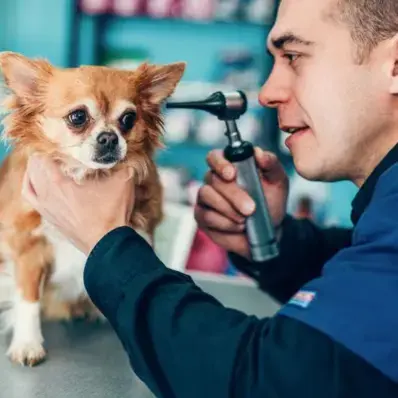Types of Deafness in Dogs
Understanding the different types of hearing loss in dogs is essential for early detection and proper care. Let’s explore the two main forms of deafness and how they affect your dog’s ability to hear.
- Partial Deafness – Dogs with partial hearing loss may struggle to hear certain frequencies or may only be able to hear in one ear (unilateral deafness). Infections, inflammation, injury, or age-related deterioration often cause this type of hearing loss. Some cases may be reversible with treatment.
- Complete Deafness – Also known as total hearing loss, this occurs when a dog loses all ability to hear in one or both ears. It can be congenital (present at birth) due to genetic factors, or it can develop over time due to conditions like chronic infections, trauma, and noise exposure.
What Causes Deafness in Dogs?
Just like humans, dogs can experience gradual hearing loss as they age. This is known as presbycusis and usually begins around the age of 8-10 years. Older dogs may simply lose hearing due to the wear and tear on the inner ear structures.
Congenital Deafness
Some dogs are born deaf, a condition known as congenital deafness. It can be inherited, especially in certain dog breeds like Dalmatian, Australian Cattle Dog, Russell Terrier, Catahoula Leopard, Cocker Spaniel, and Bull Terrier. Dogs with merle or white coat colors are more likely to be born deaf due to genetic factors. Deafness in puppies can be detected early and may affect one or both ears.
Health Conditions
Several medical issues can contribute to hearing loss in dogs:
- Ear Infections: Chronic ear infections, such as yeast infections and especially those that are left untreated, can damage the structures of the inner ear, leading to deafness.
- Trauma: Injury to the ear or head, such as a blow or excessive loud noises, can cause permanent deafness.
- Medications: Certain drugs are toxic, particularly antibiotics like gentamicin, which can be ototoxic (toxic to the dog’s ear canal) and lead to hearing loss.
- Hypothyroidism in Dogs: This condition can cause neurological issues, including hearing loss, due to nerve damage or changes in metabolism affecting ear function.
- Lymphoma in Dogs: Canine lymphoma may affect the central nervous system, potentially impacting hearing and balance.
Noise-Induced Hearing Loss
Repeated exposure to loud, sharp noises, such as gunfire, can gradually lead to hearing loss in dogs. This type of deafness is more common in hunting and military dogs. Protective gear is available to help reduce the risk for dogs frequently exposed to high noise levels. Deafness in dogs can be permanent, but not all dogs will become completely deaf. Some may experience partial hearing loss depending on the cause.
Signs of Deafness in Dogs
Deafness in dogs can develop gradually, so the signs may be subtle at first.
Here’s what to look for:
- Not Responding to Calls or Noises A deaf dog may not react to calls, doorbells, or even the sound of their name being spoken. If your dog previously responded to sounds but no longer does, it may indicate hearing loss.
- Lack of Response to Familiar Sounds Dogs are generally sensitive to high-pitched sounds, such as squeaky toys or the rustling of treats. If your dog no longer responds to these sounds, it could be a sign of hearing loss.
- Increased Sleeping or Lethargy Deaf dogs may sleep more often or appear less energetic because they don’t react to environmental sounds that usually keep them alert.
- Behavioral Changes Some dogs may become more withdrawn or show signs of aggression due to the confusion and frustration caused by their inability to hear.
Diagnosing Deafness in Dogs
If you suspect your dog is experiencing hearing loss, it’s crucial to seek veterinary advice. The veterinarian will conduct tests to confirm the diagnosis.
- Brainstem Auditory Evoked Response BAER Test: This is the most accurate test to diagnose deafness in dogs. It measures the brain’s response to sound stimuli and helps determine the extent of the hearing loss.
- Physical Examination: The vet will also check for ear infections, blockages, or other physical issues that might be contributing to the deafness.
Early diagnosis is key to ensuring the best care and adapting your dog’s lifestyle to accommodate their condition.
Managing and Living with a Deaf Dog
Living with a deaf dog requires some adjustments, but with patience and training, your dog can lead a happy life.
Training Tips for Deaf Dogs
Deaf dogs can still be trained, but you’ll need to use visual cues instead of vocal commands. Some common techniques include:
- Hand signals: Teach your dog to respond to specific hand movements.
- Flashlights or Vibration Collars: Use these to get your dog’s attention before giving them a command.
- Positive Reinforcement: Use treats and praise to reward your dog when they respond correctly to visual cues.
Communicating with Your Deaf Dog
- Use clear, consistent hand gestures.
- Examine your dog and make sure can see you when you are signaling them.
- Tap the floor or use vibrations to get their attention before giving them commands.
Safety Considerations
Deaf dogs can be more vulnerable in certain situations, especially in outdoor environments. It’s important to ensure they are always safe:
- Keep your dog on a leash in public spaces.
- Be cautious of traffic and loud environments where they may not hear approaching dangers.
- Use reflective gear for visibility during walks.
Deaf Dog Care
- Regular ear check-ups are crucial to ensure the health of your dog’s ears.
- Keep their ears clean and free from infection, but avoid sticking anything into the ear canal.
- Ensure your dog’s environment is quiet and comfortable for relaxation.
Treatment Options for Deafness in Dogs
Unfortunately, most forms of deafness in dogs, especially age-related and congenital defects, are irreversible. However, some cases caused by infections or trauma may be treatable.
- Medication: If the dog loses hearing loss due to an infection, the vet may prescribe antibiotics or antifungal medication.
- Surgery: In rare cases, surgery might be an option to correct ear issues or remove tumors affecting hearing.
- Prosthetics: While still experimental, some veterinary researchers are exploring the use of cochlear implants for dogs.
Preventing Deafness in Dogs
While not all causes of deafness can be prevented, there are steps you can take to reduce the risk:
- Regular Ear Check-ups: Early detection of ear infections or blockages can help prevent hearing loss.
- Ear Hygiene: Keep your dog’s ears clean and dry to prevent infections. Be sure to consult your vet before cleaning their ears.
- Protect Your Dog from Loud Noises: Avoid exposing your dog to extremely loud environments, which can cause trauma to their hearing.
Deafness in dogs is a condition that requires understanding, patience, and adaptation. While it can be challenging, many deaf dogs lead happy, healthy lives with the right care and attention.








